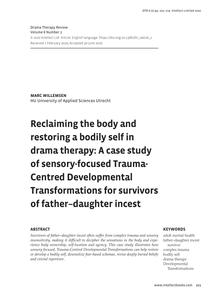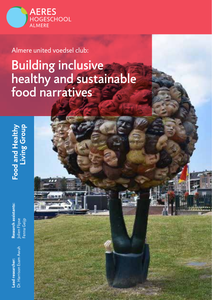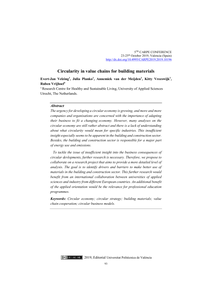Survivors of father–daughter incest often suffer from complex trauma and sensory insensitivity, making it difficult to decipher the sensations in the body and experience body ownership, self-location and agency. This case study illustrates how sensory focused, Trauma-Centred Developmental Transformations can help restore or develop a bodily self, desensitize fear-based schemas, revise deeply buried beliefs and extend repertoire.
DOCUMENT

The aim was to study the needs, opportunities and effects of citizen engagement in the urban food system transition. This addresses the issue of - ‘how’, ‘in what ways’ and ‘through what methods’ - citizens can be engaged in the developments towards a more sustainable and healthy regional food system. The research project sought to investigate the roles citizen engagement can take in the transformation of the urban food environment towards healthier and sustainable food consumption patterns. The study covers desired food futures; food discourse; the message our bodies convey about our eating habits; the effect of Covid-19 on food pattern transformations; the term 'organic' in relation to food; mass media as a source of information about food.
DOCUMENT

Completeness of data is vital for the decision making and forecasting on Building Management Systems (BMS) as missing data can result in biased decision making down the line. This study creates a guideline for imputing the gaps in BMS datasets by comparing four methods: K Nearest Neighbour algorithm (KNN), Recurrent Neural Network (RNN), Hot Deck (HD) and Last Observation Carried Forward (LOCF). The guideline contains the best method per gap size and scales of measurement. The four selected methods are from various backgrounds and are tested on a real BMS and metereological dataset. The focus of this paper is not to impute every cell as accurately as possible but to impute trends back into the missing data. The performance is characterised by a set of criteria in order to allow the user to choose the imputation method best suited for its needs. The criteria are: Variance Error (VE) and Root Mean Squared Error (RMSE). VE has been given more weight as its ability to evaluate the imputed trend is better than RMSE. From preliminary results, it was concluded that the best K‐values for KNN are 5 for the smallest gap and 100 for the larger gaps. Using a genetic algorithm the best RNN architecture for the purpose of this paper was determined to be GatedRecurrent Units (GRU). The comparison was performed using a different training dataset than the imputation dataset. The results show no consistent link between the difference in Kurtosis or Skewness and imputation performance. The results of the experiment concluded that RNN is best for interval data and HD is best for both nominal and ratio data. There was no single method that was best for all gap sizes as it was dependent on the data to be imputed.
MULTIFILE

Buildings need to be carefully operated and maintained for optimum health, comfort, energy performance, and utility costs. The increasing use of Machine Learning combined with Big Data in the building services sector has shown the potential to bring energy efficiency and cost-effectiveness. Therefore, upskilling and reskilling the current workforce is required to realize new possibilities. In addition, sharing and preserving knowledge are also required for the sustainable growth of professionals and companies. This formed the basis for the Dutch Research Council funded TransAct project. To increase access to education on the job, online learning is experiencing phenomenal growth. A study was conducted with two focus groups - professionals of a building service company and university researchers - to understand the existing challenges and the ways to improve knowledge sharing and upskilling through learning on the job. This study introduced an Enterprise Social Network platform that connects members and may facilitate knowledge sharing. As a community forum, Yammer from office 365 was used. For hosting project files, a SharePoint page was created. For online courses, the company’s online learning site was utilized. The log data from the online tools were analysed, semi-structured interviews and webinars were conducted and feedback was collected with google forms. Incentive models like social recognition and innovative project results were used to motivate the professionals for online activities. This paper distinguishes the impacts of initiatives on the behaviour of university researchers vs company employees.
DOCUMENT

Temporary transformations of vacant buildings could alleviate the shortage of housing for urgent home seekers. However, not much is known about the transformation of buildings into temporary, adequate, and affordable housing. A multidisciplinary literature review covering design, indoor environmental quality, housing, and environmental psychology, was performed to determine if such an integrative approach could shed light on a new perspective to provide housing for ‘urgent home seekers’. Subsequently, building transformation case studies were compared with the literature review findings. It is concluded that there is a gap in knowledge on how the concept of ‘home’ can be added to existing regulations in order to design and realise temporary housing that fits the needs of urgent home seekers.
DOCUMENT
Population ageing has become a domain of international discussions and research throughout the spectrum of disciplines including housing, urban planning, and real estate. Older people are encouraged to continue living in their homes in their familiar environment, and this is referred to as “ageing-in-place”. Enabling one to age-in-place requires new housing arrangements that facilitate and enable older adults to live comfortably into old age, preferably with others. Innovative examples are provided from a Dutch social housing association, illustrating a new approach to environmental design that focuses more on building new communities in conjunction with the building itself, as opposed to the occupational therapeutic approaches and environmental support. Transformation projects, referred to as “Second Youth Experiments”, are conducted using the Røring method, which is based on the principles of co-creation. De Benring in Voorst, The Netherlands, is provided as a case study of an innovative transformation project. This project shows how social and technological innovations can be integrated in the retrofitting of existing real estate for older people. It leads to a flexible use of the real estate, which makes the building system- and customer preference proof. Original article at: https://doi.org/10.3390/buildings8070089 © 2018 by the authors. Licensee MDPI.
MULTIFILE

The current multiple crisis require architects, designers, citymakers and stakeholders to re-think their approach to the city and territory, under the urge for a sustainable and inclusive future. While uncertainty and technocracy dominate, they also enable a open investigation and understanding of different future scenarios of spatial transformation. A revision of the term ‘adaptability’ promises to contribute to a new holistic approach.This paper presents the outputs of our current research project on adaptability at architectonic and urban level. It departs from the spatial disciplinary literature, and a large database of projects where this term plays a role implicitly or explicitly. We revisit theories and reposition them in the current unstable context. With this, we can enlarge the range of interactions and scales to approach simultaneously. Based on this, we propose new variables, and vocabularies in a framework for urban development beyond traditional confines.In fact, a new framework for the design of architectonic and urban space is articulated. It responds to different transformations of users’, usages’ and environmental conditions based on dimensions (scale, time, space), domains (social, economic, ecologic, climatic), adaptability ingredients (modularity, flexibility, interactivity, etc.), and resources (design by research, extreme scenario-thinking). We show them in action thought design projects conducted with students in the Netherlands and Belgium.We aim at generating holistic insights on the concept and methods of adaptability through some of the research and educational outcomes. Ultimately, we want to expand the mechanism of planning for an adaptive approach -from the building to the network, making lines of research, education and practice collide to address urgently needed changes.
MULTIFILE

Completeness of data is vital for the decision making and forecasting on Building Management Systems (BMS) as missing data can result in biased decision making down the line. This study creates a guideline for imputing the gaps in BMS datasets by comparing four methods: K Nearest Neighbour algorithm (KNN), Recurrent Neural Network (RNN), Hot Deck (HD) and Last Observation Carried Forward (LOCF). The guideline contains the best method per gap size and scales of measurement. The four selected methods are from various backgrounds and are tested on a real BMS and meteorological dataset. The focus of this paper is not to impute every cell as accurately as possible but to impute trends back into the missing data. The performance is characterised by a set of criteria in order to allow the user to choose the imputation method best suited for its needs. The criteria are: Variance Error (VE) and Root Mean Squared Error (RMSE). VE has been given more weight as its ability to evaluate the imputed trend is better than RMSE. From preliminary results, it was concluded that the best K‐values for KNN are 5 for the smallest gap and 100 for the larger gaps. Using a genetic algorithm the best RNN architecture for the purpose of this paper was determined to be Gated Recurrent Units (GRU). The comparison was performed using a different training dataset than the imputation dataset. The results show no consistent link between the difference in Kurtosis or Skewness and imputation performance. The results of the experiment concluded that RNN is best for interval data and HD is best for both nominal and ratio data. There was no single method that was best for all gap sizes as it was dependent on the data to be imputed.
DOCUMENT

The urgency for developing a circular economy is growing, and more and more companies and organisations are concerned with the importance of adapting their business to fit a changing economy. However, many analyses on the circular economy are still rather abstract and there is a lack of understanding about what circularity would mean for specific industries. This insufficient insight especially seems to be apparent in the building and construction sector. Besides, the building and construction sector is responsible for a major part of energy use and emissions. To tackle the issue of insufficient insight into the business consequences of circular developments, further research is necessary. Therefore, we propose to collaborate on a research project that aims to provide a more detailed level of analysis. The goal is to identify drivers and barriers to make better use of materials in the building and construction sector. This further research would benefit from an international collaboration between universities of applied sciences and industry from different European countries. An additional benefit of the applied orientation would be the relevance for professional education programmes. The article is published in the proceedings of the conference : http://dx.doi.org/10.4995/CARPE2019.2019.10582 Publisher Editorial Universitat Politècnica de València, 2019 www.lalibreria.upv.es / Ref.: 6523_01_01_01 Creative Commons Atribution-NonCommercial-NonDetivates-4.0 Int.
MULTIFILE
